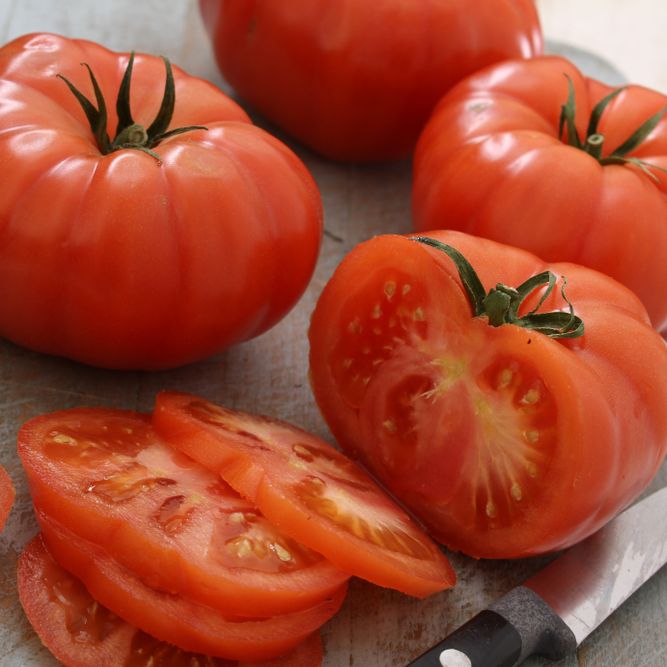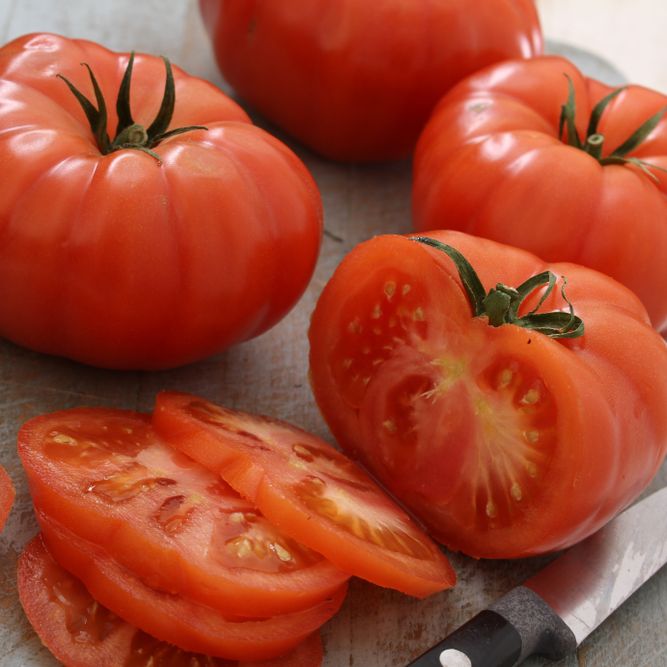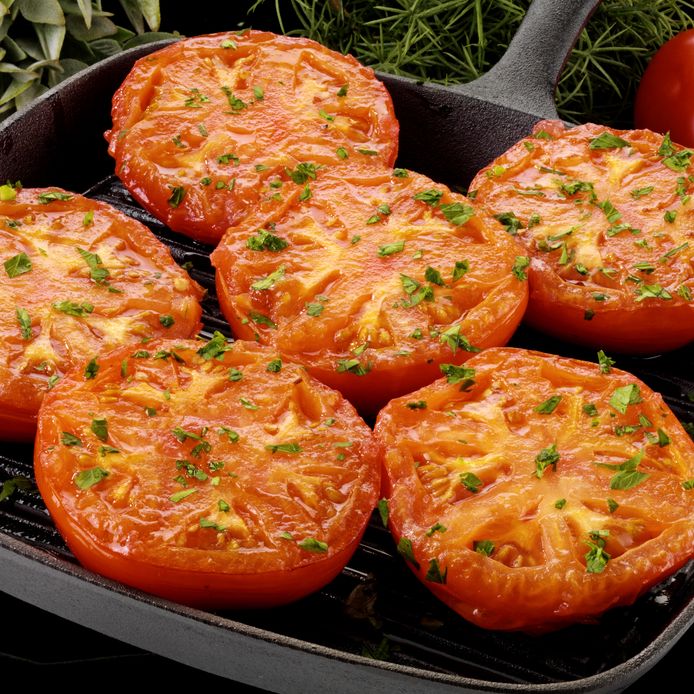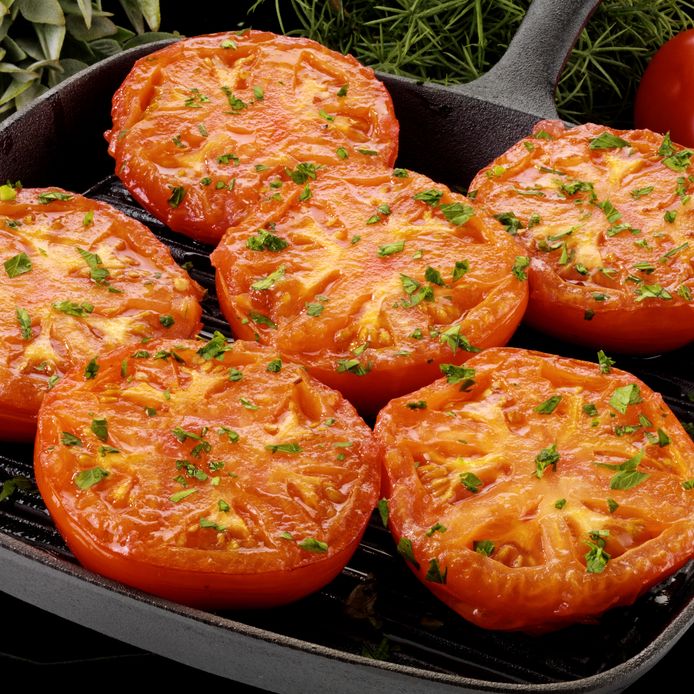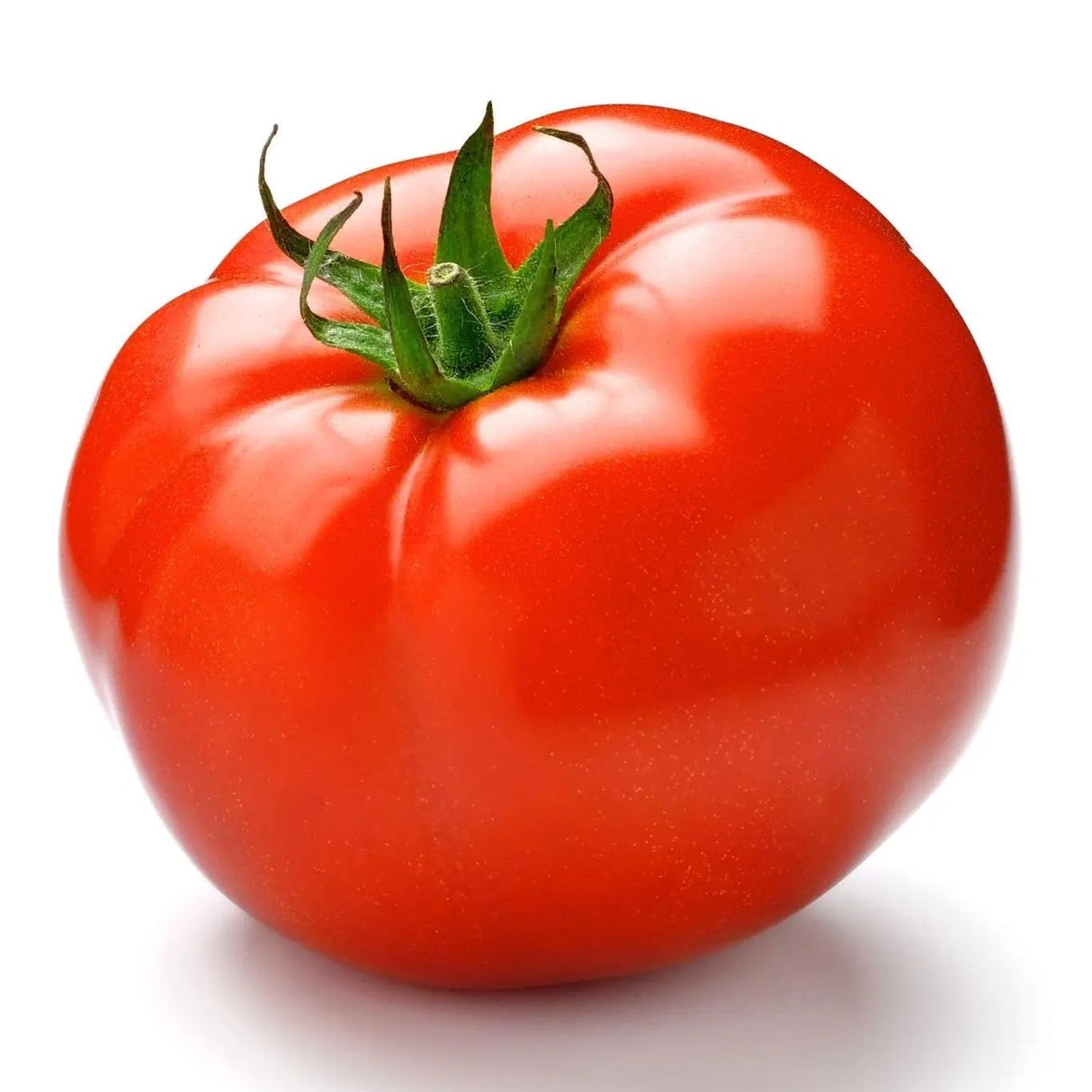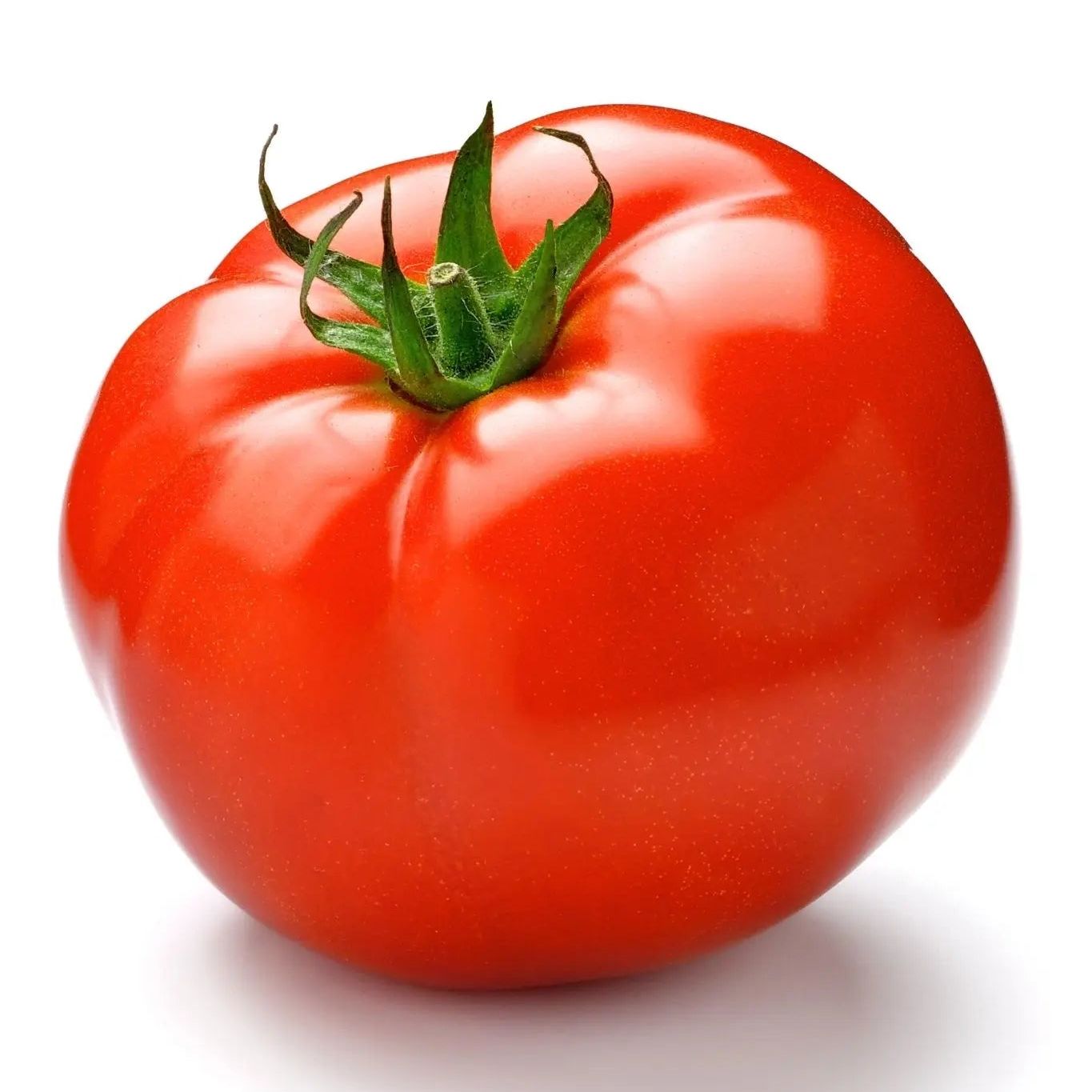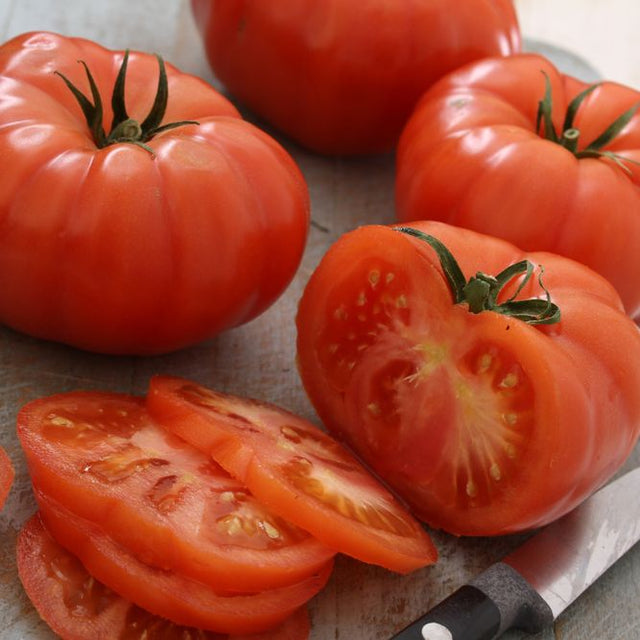Tomato Seeds - Indeterminate - Abraham Lincoln Original Beefsteak
Classic heirloom beefsteak with rich flavor, crack resistance, and high yields.
- Non-GMO Safe Seed Pledge
- Seed packets printed on forestry-certified paper (FSC, SFI, Rainforest Alliance)
- Curbside-recyclable mailers; SFI-certified kraft paper
- 1% for the Planet partner — supports environmental nonprofits
- Compact, energy-efficient facility with lean, low-waste operations
- Seeds: When properly stored, planted, and cared for, we guarantee reasonable germination and true-to-type growth for one year from purchase.
- Non-seed products: Free from defects in materials and workmanship for 30 days from shipment.
Excludes factors outside our control (extreme weather, pests, gardener error). If something’s off, contact us—we’ll make it right with a replacement, repair, or refund.
We do not sell seeds that are GMO or BE.
USDA “bioengineered (BE)” foods are those with detectable genetic material that was modified using in vitro recombinant DNA (rDNA) techniques, in ways not obtainable through conventional breeding or found in nature. The USDA’s National Bioengineered Food Disclosure Standard uses “bioengineered” as the nationwide labeling term.
- Detectable modified genetic material in the final food
- Created via in vitro rDNA techniques (e.g., gene transfer)
- Modifications not achievable through conventional breeding or nature
Description
A legendary heirloom from the late 1920s, Abraham Lincoln Original Beefsteak Tomato delivers the classic, old-fashioned flavor home gardeners love — rich, balanced, and distinctly sweet. Its large, deep-red fruits average 10–12 ounces, with smooth, uniform shoulders and meaty, nearly seedless interiors that make every slice a showcase of texture and taste.
Plants are indeterminate, vigorous, and high-yielding, continuing to produce throughout the season. Fruits ripen in about 80–85 days, thriving in warm, sunny conditions with steady moisture. The Abraham Lincoln Original resists cracking and performs reliably even in humid regions, producing full clusters of well-shaped tomatoes that are as beautiful as they are delicious.
Ideal for fresh slicing, canning, juicing, and sauces, its thick flesh and balanced acidity lend themselves perfectly to both table and kitchen use. The variety’s long-standing reputation for productivity and superb flavor makes it a favorite among market growers and heritage gardeners alike.
A timeless heirloom that lives up to its name — dependable, honest, and abundantly generous, just like the American icon it honors.
Your payment is processed securely via trusted gateways. We do not store credit card details and we do not have access to your card information.
Couldn't load pickup availability
1. Choosing the Right Location
Light Requirements:
Tomatoes are sun-loving plants that require at least 6–8 hours of direct sunlight daily, though 8–10 hours is ideal for strong fruit set and flavor. Choose a site with full southern exposure whenever possible. Avoid shaded areas near trees, fences, or tall crops. Plants grown in partial sun may produce leggy growth and fewer fruits.
Soil Requirements:
Tomatoes thrive in well-drained, loamy soil enriched with organic matter. The optimal pH range is 6.0–6.8, though they tolerate slightly acidic conditions. Prepare beds ahead of time by incorporating aged compost, leaf mold, or well-rotted manure to improve structure, fertility, and microbial activity.
Avoid compacted or waterlogged soil, which restricts root growth.
Sandy soils warm faster and suit early crops; heavier soils retain moisture better in dry climates.
Rotate planting sites annually to prevent nutrient depletion and disease buildup.
Soil Preparation Tip:
Before sowing or transplanting, loosen the top 8–12 inches of soil and blend in 2–3 inches of organic compost. If needed, amend with bone meal for phosphorus and greensand or kelp meal for potassium to promote strong roots and flowering.
2. Starting Seeds Indoors
Timing:
Sow tomato seeds 6–8 weeks before the final expected frost date. Adjust timing to your region so that transplants are ready to go outside once the soil has warmed to at least 60°F (16°C) and nighttime temperatures remain above 50°F (10°C).
Containers and Medium:
Use clean trays or small pots filled with a sterile, fine-textured seed-starting mix. Avoid heavy garden soil, which compacts easily and harbors pathogens.
Sowing Depth:
Sow seeds ¼ inch deep, cover lightly, and mist gently to settle the soil. Maintain even moisture—damp but never soggy.
Germination Conditions:
Tomato seeds germinate best at 75–85°F (24–29°C). Use a heat mat if needed. Germination typically occurs within 5–10 days, though some heirloom varieties may take up to two weeks.
Light After Germination:
Once sprouts appear, move trays to a bright, warm location or under full-spectrum grow lights. Provide 14–16 hours of light per day to prevent leggy growth. Keep lights about 2–3 inches above the seedlings and raise them as plants grow.
3. Transplanting Seedlings
Thinning:
Once seedlings develop their first set of true leaves, thin weaker ones to ensure each has ample light and airflow. Handle gently by the leaves, not the stems.
Potting Up:
When seedlings reach 3–4 inches tall, transplant them into larger pots (3–4 inches wide). Bury the stems up to the first true leaves—tomatoes form new roots along buried stems, creating stronger plants.
Hardening Off:
7–10 days before transplanting outdoors, gradually acclimate plants to outdoor conditions:
Start with 1–2 hours of filtered sun the first day.
Increase exposure each day, reducing watering slightly to toughen the stems.
Avoid windy or cold days during hardening.
4. Planting Outdoors
Timing:
Transplant tomatoes after the danger of frost has passed and the soil is warm. Soil temperatures below 55°F (13°C) can stunt root growth. Early planting can be improved by warming the soil with black plastic or row covers two weeks prior to transplanting.
Planting Depth:
Plant deeply—bury the stem up to the first or second set of true leaves. This encourages a robust root system. In heavy clay soil, plant slightly shallower and mound soil around the base.
Spacing:
Determinate (bush) types: 18–24 inches apart
Indeterminate (vining) types: 24–36 inches apart
Rows: Space rows 30–42 inches apart for good airflow and access.
Proper spacing reduces humidity around leaves, helping prevent fungal disease and promoting even ripening.
Watering at Planting:
Water thoroughly after transplanting to settle soil around the roots. Use lukewarm, non-chlorinated water. Avoid overhead watering—direct it at the base to minimize leaf wetness and disease spread.
5. Watering and Moisture Management
Initial Watering:
Keep the soil evenly moist but never waterlogged during germination and early growth. Light, frequent watering helps young roots establish.
Ongoing Watering:
Once established, switch to deep, infrequent watering, encouraging roots to grow downward. Aim for about 1–1.5 inches of water per week, adjusting for weather and soil type. Water early in the day so foliage dries before evening.
Organic Tip:
Use rainwater whenever possible—its natural minerals and softness encourage better plant health compared to chlorinated tap water.
6. Temperature and Climate Conditions
Tomatoes favor warm conditions with daytime temperatures between 70–85°F (21–29°C) and nighttime temperatures above 55°F (13°C). Extended cold slows growth, while prolonged heat above 95°F (35°C) may reduce fruit set.
In hot climates, provide light afternoon shade using shade cloth or tall companion crops (basil, corn, or sunflowers). In cooler regions, use row covers or cloches to retain warmth during early growth. Maintain steady soil warmth for optimal root activity.
7. Fertility and Soil Feeding
Before planting, mix compost into the soil at a rate of about 1 part compost to 3 parts native soil. Tomatoes are moderate-to-heavy feeders but respond best to slow, balanced nutrition.
At planting time: mix a small handful of organic tomato fertilizer, bone meal, or worm castings into the hole.
Mid-season: side-dress with compost or dilute fish emulsion every 3–4 weeks.
Avoid over-fertilizing with nitrogen, which produces lush foliage but few fruits.
8. Early Support and Spacing Care
Install stakes, cages, or trellises at planting to avoid root disturbance later. Even determinate types benefit from light support to prevent fruit from touching the soil.
Maintain generous spacing to improve air circulation and light penetration—critical for disease prevention and even ripening.
9. Mulching and Moisture Control
After transplanting, apply 2–3 inches of organic mulch (straw, shredded leaves, or composted bark) around the base of each plant. Leave a small gap around the stem to prevent rot.
Mulch helps:
Retain soil moisture
Regulate temperature
Suppress weeds
Prevent soil from splashing onto leaves (reducing blight risk)
Refresh mulch as it decomposes throughout the season.
10. Organic Pest and Disease Prevention at Planting
Healthy soil and spacing are your best defense. Avoid synthetic chemicals—rely on prevention and natural balance.
Pests: Keep an eye out for aphids, hornworms, and whiteflies. Use neem oil, insecticidal soap, or hand-picking to control populations early.
Disease Prevention:
Water at the base to avoid wet leaves.
Provide good air flow between plants.
Rotate crops yearly; avoid planting tomatoes after peppers, potatoes, or eggplants.
Use compost teas (aerated or non-aerated) as a soil drench to boost microbial health.
Companion plants like basil, marigold, garlic, and borage help deter pests naturally while enhancing pollination and flavor.Choosing the Right Location:
Light Requirements: Tomato - Yellow Pear thrives in full sun. Select a location that receives at least 6-8 hours of direct sunlight daily.
Soil Requirements: Prefers well-drained, fertile soil with a pH of 6.0-6.8. Although adaptable to various soil types, it grows best in loamy soil enriched with organic matter.
Planting Seeds:
Timing: Start seeds indoors 6-8 weeks before the last expected frost date. Transplant seedlings outdoors after the last frost when the soil has warmed.
Sowing Depth: Sow seeds 1/4 inch deep in seed-starting mix. Cover lightly with soil and water gently.
Spacing: Thin seedlings to 18-24 inches apart when transplanting to allow adequate space for growth. Rows should be spaced about 24-36 inches apart.
Watering:
Initial Watering: Keep the soil consistently moist but not waterlogged until the seeds germinate, which typically takes 7-14 days.
Ongoing Watering: Once established, water deeply and regularly, especially during dry periods. Water the plants at the base to avoid wetting the foliage, which can lead to fungal diseases.
Temperature and Climate:
Preferred Temperature: Tomato - Yellow Pear grows best in warm temperatures ranging from 70-85°F (21-29°C). It can tolerate higher temperatures but may require more frequent watering during extreme heat.
Fertilization:
Feeding: Incorporate organic matter such as compost into the soil before planting. Use a balanced, all-purpose fertilizer at planting time and side-dress with compost or organic fertilizer mid-season.
Pruning and Thinning:
Thinning: Thin seedlings to prevent overcrowding, which can hinder growth and reduce air circulation.
Pruning: Prune suckers (the small shoots that grow between the stem and branches) to promote larger fruit production. Stake or cage plants to support the vines and improve air circulation.
Mulching:
Mulch Application: Apply a layer of organic mulch around the base of the plants to retain soil moisture, suppress weeds, and regulate soil temperature. Avoid piling mulch directly against the stems to prevent rot.
Pest and Disease Management:
Common Pests: While tomatoes can attract pests such as aphids, tomato hornworms, and whiteflies, using insecticidal soap or neem oil can help control these pests if necessary.
Diseases: Ensure good air circulation around the plants to prevent fungal diseases. Avoid overhead watering to minimize the risk of mildew and other fungal issues. Crop rotation and proper spacing can also help reduce disease incidence.
Watering
Provide 1–1½ inches of water per week, adjusting for rainfall and heat. Deep, infrequent watering encourages deep root development and helps prevent issues like blossom end rot and cracking.
Best method: Use drip irrigation or soaker hoses to deliver water directly to the soil, keeping leaves dry and minimizing fungal disease.
If overhead watering is necessary, do it early in the morning so foliage can dry quickly before nightfall.
Avoid inconsistent watering—cycles of dryness followed by heavy soaking cause splitting and irregular fruit growth. Once fruits begin ripening, slightly reduce watering to concentrate sugars and enhance the tomato’s rich flavor.
Fertilizing
Feed plants every 2–3 weeks with a balanced fertilizer (10-10-10) or organic equivalent during early vegetative growth.
When the first blossoms appear, transition to a low-nitrogen, high-potassium formula (5-10-10 or 4-6-8) to support abundant fruiting and prevent excessive leaf growth.
Supplement with calcium (via bone meal or calcium nitrate) to reduce blossom end rot, and use compost tea or seaweed extract monthly for micronutrients and soil vitality.
Avoid overfeeding with nitrogen—lush vines and few fruits are the usual result.
Weeding & Mulching
Keep the base area weed-free, as weeds compete for nutrients and invite pests.
Apply 2–3 inches of mulch (straw, compost, or shredded leaves) once soil has warmed. Mulch moderates temperature swings, preserves moisture, and prevents soil splash that spreads disease.
In cooler regions, use black plastic mulch early in the season to warm soil, then replace with organic mulch once summer heat sets in. When hand-weeding, loosen soil carefully—tomato roots are extensive but shallow near the surface.
Sun & Temperature Management
Tomatoes demand full sun—at least 6–8 hours daily—to achieve full size and flavor.
Ideal daytime temperatures: 75–85°F (24–29°C)
Nighttime temperatures: 60–70°F (16–21°C)
During heat waves above 90°F (32°C), flowers may drop or fail to pollinate. Use 30–40% shade cloth or interplant with taller crops for temporary shelter.
Ensure ample airflow between plants to reduce humidity buildup, prevent leaf spot, and strengthen stems.
Spacing & Support
Plant 24–36 inches apart in rows 3–4 feet apart. Abe Lincoln is an indeterminate variety, so it requires staking, cages, or trellises to manage continuous growth and heavy fruit clusters.
Prune suckers (side shoots) below the first flower cluster to focus energy on main stems and improve air circulation. Secure vines loosely with soft ties to prevent stem damage.
Regular pruning also enhances sunlight exposure and fruit quality throughout the season.
Companion Planting
Good companions: Basil, carrots, onions, marigolds, parsley, chives, and lettuce—all deter pests and attract beneficial insects like bees and lacewings.
Avoid: Fennel, corn, and brassicas (such as cabbage or broccoli), which compete for nutrients or attract tomato pests.
Plant basil near each tomato—it repels hornworms and enhances tomato flavor when grown nearby. Interplanting with flowers like nasturtiums or calendula further deters aphids and whiteflies.
Container Growing
Suitable for large containers (minimum 10–15 gallons). Use a high-quality, well-draining potting mix enriched with compost. Support plants with sturdy cages or stakes from the start.
Container tomatoes require daily moisture checks, as pots dry faster than ground soil. In midsummer, shade the sides of containers to prevent root overheating.
Feed lightly but consistently—nutrients leach faster in containers. A liquid tomato fertilizer every 10–14 days keeps plants vigorous and productive.
Season Extension
For an early start, use cloches, cold frames, or row covers to protect young plants from spring chill.
As autumn nears, cover plants with frost blankets or low tunnels to extend harvest into late fall.
In mild or frost-free climates, tomatoes may be overwintered by trimming back vines, reducing watering, and placing them in a sunny, sheltered location—though most gardeners replant fresh each year for best vigor and yield.
Harvesting
Stage Options: Harvest when fruits are deep red, firm, and fully colored, with a gentle give under light pressure. Slight green shoulders are normal in this heirloom variety and do not affect flavor.
Technique: Use pruning shears or scissors to clip tomatoes with a short piece of stem attached. Avoid twisting or pulling—vines are tender and easily damaged, which can reduce ongoing fruit set.
Frequency: Check plants every 2–3 days during peak ripening. Regular harvesting keeps vines productive and prevents overripe fruit from attracting pests.
Maturity Signs: Fully ripe fruits detach easily, have a glossy skin, and a rich, tomato aroma.
Flavor & Nutrition
Flavor Profile: The Abe Lincoln Original Beefsteak delivers a classic, old-fashioned tomato flavor—rich, balanced, and meaty, with low acidity and a subtle sweetness ideal for slicing and canning.
Nutrition: Excellent source of vitamins A, C, and K, plus lycopene, an antioxidant linked to heart health and reduced inflammation. High water content contributes to its juicy texture, while natural sugars give depth to sauces and sandwiches.
Flavor Tip: For the most robust taste, slightly reduce watering as fruits begin to ripen. This concentrates sugars and acidity for that signature heirloom depth. Avoid overfertilization or heavy nitrogen late in the season—it can dilute flavor.
Handling
Picking Care: Handle fruits gently to avoid bruising. Ripe tomatoes are delicate and easily split when squeezed.
Washing: Rinse only before eating or processing. Washing before storage encourages mold and spoilage.
Work Area: Use clean shears and harvest baskets to prevent spreading disease between plants. Disinfect tools with a mild bleach solution or vinegar rinse between uses.
Post-Harvest Handling: Lay harvested fruit in single layers in shallow trays to prevent bruising. Keep stems pointed upward to avoid puncturing neighboring fruits.
Storage & Preservation
Fresh Storage: Keep tomatoes at room temperature (60–70°F / 16–21°C) until ripe. Avoid refrigeration unless fully ripe and intended for extended keeping; cold temperatures mute flavor and alter texture.
Freezing: Core, chop, or puree ripe tomatoes and freeze in airtight containers. Ideal for soups and sauces.
Drying: Slice ¼ inch thick and dry at 125°F (52°C) in a dehydrator or warm, airy space until leathery. Store in jars with desiccant packets.
Canning: Perfect for sauce, juice, or stewed tomato preservation due to dense flesh and low seed content. Use a water bath canner or pressure canner following safe preservation guidelines.
Flavor Extension: Roasting ripe tomatoes before freezing or canning intensifies sweetness and smoky richness.
Kitchen Use
Fresh: Slice thick for sandwiches, burgers, and caprese salads.
Cooked: Ideal for sauces, soups, and roasting—its meaty flesh cooks down beautifully without excess water.
Grilled/Roasted: Brush with olive oil and herbs; roast at 400°F (204°C) for 20–25 minutes to enhance natural sugars.
Pairings: Complements basil, garlic, oregano, balsamic vinegar, mozzarella, black pepper, and sea salt.
Flavor Combination Tip: For peak culinary results, combine Abe Lincoln with a small proportion of high-acid or cherry tomatoes to balance sauces naturally.
Growing & Pruning Tips
Growth Habit: Indeterminate vines reach 6–8 feet or more, producing continuously until frost. Provide tall stakes, trellises, or heavy-duty cages to support fruit-laden branches.
Pruning: Remove suckers below the first flower cluster to improve airflow and focus energy on fruiting. Moderate pruning reduces disease risk but avoid excessive leaf removal, which can lead to sunscald.
Soil Care: Maintain evenly moist soil and consistent feeding during fruit set. Mulch generously to stabilize soil temperature and moisture.
Fertilizing: After flowering, reduce nitrogen and increase potassium and phosphorus to enhance fruit development and flavor concentration.
End-of-Season Tip: As frost approaches, pinch off new blooms and small green fruits so the plant focuses energy on ripening existing tomatoes.
Container & Watering Tips
Container Size: Minimum 10–15 gallons per plant. Use sturdy cages and deep pots with 4+ drainage holes.
Drainage: Essential—tomatoes dislike soggy roots. Mix compost, perlite, or coarse sand into soil for better aeration.
Watering Rhythm: Water deeply when the top inch of soil feels dry. Avoid frequent shallow watering, which promotes weak roots and cracking.
Root Protection: Shade pot sides in midsummer and mulch tops to keep root temperatures stable and prevent stress-related leaf curl.
Feeding: Use a diluted tomato-specific liquid fertilizer every 10–14 days once flowering begins.
Companion Planting & Pollinators
Good Companions: Basil, marigold, parsley, chives, onions, carrots, lettuce, and nasturtium—all attract beneficial insects and repel common pests.
Trap Crops: Nasturtiums and radishes lure aphids and flea beetles away from tomato vines.
Pollination Tip: Tomatoes are self-fertile, but bee visits and gentle hand-shaking of blossoms improve fruit set and uniformity.
Wildlife Note: If birds peck at ripe fruits, hang shiny tape, lightweight mesh, or reflective ornaments nearby for deterrence.
Seed Saving
Selection: Choose fully ripe, disease-free, true-to-type fruits from strong, productive plants.
Fermentation Method: Scoop seeds with gel and place in a jar with water for 2–3 days, stirring daily until a thin mold forms—this breaks down the germination-inhibiting coating.
Cleaning & Drying: Rinse thoroughly, spread on paper or mesh, and dry for 7–10 days in a shaded, ventilated area.
Storage: Store completely dry seeds in airtight containers with desiccant packets in a cool, dark place.
Viability: Up to 6 years with proper drying and storage conditions.
Purity Note: If saving seeds, isolate by 25–50 feet from other tomato varieties or bag blossoms to ensure varietal integrity.
Insects and Mites:
Like most heirloom beefsteak tomatoes, Abe Lincoln can attract a variety of common garden pests throughout the growing season. Aphids are among the most persistent, feeding on the undersides of tender leaves and stems, excreting honeydew that encourages sooty mold growth. Clusters of these tiny insects can quickly cause leaf curling, distortion, and yellowing. Whiteflies, another sap-sucking pest, often appear in warm, humid conditions and weaken plants by draining essential nutrients. Spider mites may infest plants during hot, dry spells, creating fine webbing across leaf undersides and causing stippling and premature leaf drop. Tomato hornworms, the large green caterpillars that blend in with foliage, can defoliate plants nearly overnight if left unchecked. Handpicking hornworms and disposing of them is effective for small gardens, while beneficial insects such as lady beetles, lacewings, and parasitic wasps help control aphid and mite populations naturally.
Cutworms may occasionally sever young transplants at soil level, especially in newly tilled soil, while flea beetles chew small, round holes in leaves during the early growth stages. Floating row covers can be used during the first few weeks after transplanting to protect young seedlings from both cutworms and beetles. If pest pressure increases, consider introducing natural predators or applying neem oil, pyrethrin, or insecticidal soap in the evening when pollinators are inactive.
Fungal and Bacterial Diseases:
Though known for its hardiness and reliable yields, Abe Lincoln is still susceptible to several fungal and bacterial issues that affect tomatoes, particularly in damp or humid environments. Early blight (Alternaria solani) and Septoria leaf spot are common concerns, beginning as small brown or black spots with yellow halos on the lower foliage. If not addressed, they can progress upward, defoliating the plant and exposing fruit to sunscald. Late blight (Phytophthora infestans), a more severe fungal infection, appears as irregular greasy lesions that quickly expand, turning stems black and fruit brown and leathery. Outbreaks are most common during extended periods of rain and cooler weather.
To minimize disease spread, avoid overhead watering, water at the base of the plant in the morning, and maintain good air circulation through proper spacing and pruning of the lower leaves. Always rotate tomato crops every 3–4 years, keeping them separate from related plants such as peppers, potatoes, and eggplants. Remove any diseased foliage immediately and dispose of it away from the garden area. Organic copper or sulfur-based fungicides can be applied preventatively during wet periods to reduce fungal pressure, while a layer of organic mulch will help block soil-borne spores from splashing onto the leaves.
Physiological and Nutritional Disorders:
Because of its large fruit size and heirloom genetics, Abe Lincoln is also prone to physiological disorders related to fluctuating water or nutrient levels. Blossom end rot is among the most common, caused by inconsistent soil moisture and resulting calcium uptake issues. It manifests as dark, sunken spots on the bottom of developing fruits. To prevent this, maintain steady moisture levels through deep, consistent watering and mulching. Incorporating compost or crushed eggshells into the soil before planting provides a slow-release source of calcium.
Fruit cracking and catfacing are additional problems seen in large-fruited heirlooms. Cracking occurs when fruits absorb water too rapidly after drought stress, causing the skin to split, while catfacing results from cold temperatures during flowering and leads to misshapen fruit. Though primarily cosmetic, both can be reduced by maintaining even watering, protecting young plants from temperature swings, and providing steady warmth during the fruiting period.
Viral Diseases and Environmental Stress:
While not as common, certain viral infections like Tomato Mosaic Virus (ToMV) or Tomato Yellow Leaf Curl Virus (TYLCV) can occasionally affect Abe Lincoln plants. Symptoms include mottled leaves, stunted growth, or distorted fruit. Preventive measures include using clean, sterilized tools, purchasing certified virus-free seed, and controlling whiteflies that can spread TYLCV.
Environmental extremes can also stress the plant and reduce yields. Temperatures above 95°F can inhibit pollination, while extended nighttime temperatures above 75°F may cause flower drop. Conversely, cold snaps below 55°F can delay ripening and produce uneven coloration or green shoulders on the fruit. To reduce environmental stress, apply mulch to moderate soil temperature, use shade cloth during intense heat, and cover plants with lightweight row covers during cool spring nights.
Cultural Prevention and Best Practices:
Practice three-year crop rotation to prevent soil-borne disease buildup.
Avoid planting tomatoes near members of the Solanaceae family (peppers, eggplants, potatoes).
Water deeply and consistently, at soil level rather than from above, to minimize leaf wetness.
Apply organic mulch around the base of plants to suppress weeds, retain moisture, and block soil splash.
Maintain a spacing of 24–36 inches between plants for optimal airflow and sunlight penetration.
Regularly inspect the undersides of leaves for pests or early signs of disease, treating promptly before problems spread.
Remove lower leaves touching the soil and prune interior growth to increase circulation within dense canopies.
Apply neem oil, insecticidal soap, or Bt (Bacillus thuringiensis) for organic pest management.
Keep foliage dry by watering early in the morning so plants can dry before nightfall, reducing fungal spore viability.
By following these integrated pest management and cultural care practices, growers can preserve the health and productivity of Abe Lincoln tomatoes throughout the entire growing season. When well cared for, this heirloom variety remains one of the most dependable and flavorful beefsteak tomatoes in the garden—resilient, prolific, and naturally vigorous in both home and market plots.
Q: How large do Abraham Lincoln tomatoes grow, and what is their average fruit weight?
Abe Lincoln tomatoes are known for their classic beefsteak size and robust structure. Fruits typically range from 10 to 16 ounces each, though some can exceed a full pound under ideal growing conditions. The fruits are round, slightly flattened, and deeply red with a rich, dense flesh that contains minimal seeds. Their consistent size and uniform texture make them a dependable slicing tomato, perfect for fresh table use or canning.
Q: What makes Abraham Lincoln different from other heirloom beefsteak tomatoes?
What sets Abe Lincoln apart is its balance of sweetness, acidity, and density, combined with its reliability and disease tolerance. Unlike many old-fashioned beefsteaks that can be finicky, Abe Lincoln was bred for Midwestern climates to withstand moderate stress, resist cracking, and maintain strong yields even in uneven weather. Its deep, smoky-sweet flavor profile is richer than that of modern hybrids, but it also carries a subtle tang that enhances savory dishes and sauces. The variety’s improved resistance to Alternaria stem canker and early blight also makes it more forgiving to grow than many traditional heirlooms.
Q: Why do my Abraham Lincoln tomatoes sometimes show green shoulders or uneven ripening?
Green shoulders are a common trait in large, old-fashioned tomatoes like Abe Lincoln, caused by a combination of intense sunlight, fluctuating temperatures, and uneven nutrient distribution in the fruit. This happens when the top of the tomato, near the stem, remains slightly firmer and green even as the lower portion ripens. To minimize this, ensure your plants receive consistent watering and balanced fertilization, and consider shading the fruit clusters during periods of extreme heat. While some green shoulder is natural and harmless, a gentle reduction in direct midday sunlight can improve color uniformity and skin tone.
Q: How long does it take Abraham Lincoln tomatoes to mature, and how long do they produce?
Abe Lincoln tomatoes reach maturity in 80–89 days from transplant. As an indeterminate variety, they continue producing throughout the growing season rather than setting all their fruit at once. Expect steady harvests from midsummer through early fall, especially when regularly pruned and fed. In warm climates or with season extension (such as high tunnels or row covers), production can continue well into autumn. The plants are vigorous and tall, often reaching 5 to 6 feet, requiring staking or caging for best results.
Q: How should I water and fertilize Abraham Lincoln tomatoes for optimal growth?
Tomatoes perform best with consistent deep watering, allowing soil to dry slightly between sessions but never completely. Irregular moisture is the leading cause of blossom end rot and cracking, so aim for uniform hydration through drip irrigation or soaker hoses. Apply mulch to help stabilize soil moisture and temperature. For feeding, use a balanced organic fertilizer (such as 5-5-5 or 4-6-3) every 2–3 weeks, switching to a lower-nitrogen formula once fruit begins to set. Side-dress with compost midseason to sustain nutrient availability. Avoid overfeeding with nitrogen, as it can promote excessive foliage growth at the expense of fruit.
Q: What pests or diseases should I watch out for when growing Abraham Lincoln tomatoes?
Though resilient, Abe Lincoln can occasionally experience early blight, aphids, or hornworms in humid or stressed conditions. To prevent issues, rotate crops, remove infected foliage, and maintain airflow by pruning. Introduce beneficial insects like ladybugs for pest control and use neem oil or insecticidal soap as needed. For fungal protection, apply organic copper or sulfur sprays during extended wet weather. Because Abe Lincoln is naturally tolerant to Alternaria stem canker, it generally experiences fewer severe fungal outbreaks than other heirlooms of similar size.
Q: My Abraham Lincoln plants are flowering but not setting fruit — what’s happening?
This is typically caused by temperature stress. Tomatoes require nighttime temperatures between 55–75°F for successful pollination and fruit set. If nights are cooler or days hotter than that range, pollen becomes nonviable and blossoms may drop. Once temperatures stabilize, flowering and fruiting will resume naturally. To assist during heat waves, use shade cloth to reduce afternoon stress, and during cool periods, consider covering plants with row fabric to retain warmth overnight.
Q: Can Abraham Lincoln tomatoes be grown in containers or smaller gardens?
Yes — though traditionally grown in garden plots, Abe Lincoln can thrive in large containers (minimum 10–15 gallons) with proper staking. Use a nutrient-rich, well-draining potting mix and maintain consistent feeding and watering. Container-grown plants may produce slightly smaller yields than in-ground plants, but fruits retain the same exceptional quality. Ensure at least 6–8 hours of sunlight daily, and rotate containers weekly if growing on patios to ensure even sun exposure.
Q: How long will saved seeds from Abraham Lincoln remain viable?
When properly cleaned, dried, and stored in a cool, dry, and dark place, Abe Lincoln tomato seeds can remain viable for 4 to 6 years. For best germination rates, store seeds in airtight containers with silica gel packs to control humidity. Always label your seed batches by year and generation to preserve strain purity and performance.
From Seed Indoors (Spring)
From Plant (Spring)
Fall Planting
Expected Harvest
Is this a good fit for your garden?
The story of the tomato begins long before it was ever called “beefsteak,” “heirloom,” or “Abe Lincoln.” Its roots lie in the ancient agricultural traditions of Indigenous peoples of South America, particularly within the Andean and Mesoamerican regions. Long before European contact, Native farmers of the Andes, the Nahua and Maya of Mesoamerica, and many other Indigenous nations cultivated the wild Solanum ancestors that evolved into Solanum lycopersicum. These early tomato relatives grew among maize, beans, squash, and chile within the sacred balance of the milpa system—a sustainable intercropping method that reflected harmony between people, land, and spirit.
To Indigenous farmers, tomatoes were not merely food but a living reflection of the sun and soil—symbols of fertility, warmth, and renewal. They were bred in community, not laboratories: generations of seedkeepers carefully selected for color, size, flavor, and adaptability. The first cultivated tomatoes were small and golden, later evolving into the red-fruited types that spread across Indigenous trade routes long before European colonizers ever encountered them. By the time tomatoes reached Europe in the 16th century, they already carried millennia of Native innovation and ecological wisdom within their seeds.
As the tomato traveled northward and eastward through global exchange, it adapted to countless climates and cuisines. By the 19th century, it had become a fixture of American home gardens—particularly in the fertile soils of the Midwest, where settlers and Native communities alike cultivated varieties suited to local taste and resilience. Within that era of agricultural experimentation arose a uniquely American heirloom: the Abe Lincoln Tomato.
Bred in the late 1920s by George W. Middleton of Lincoln, Illinois, the Abe Lincoln Original Beefsteak was developed for uniform red color, large size, and exceptional old-fashioned flavor. It embodied the values of the early American homestead—self-reliance, productivity, and community sharing—traits mirrored in Indigenous agricultural traditions that predate it by thousands of years. The variety was introduced by H.W. Buckbee Seed Company of Rockford, Illinois, around 1928, during a time when regional seed companies still relied heavily on hand selection and local testing rather than industrial hybridization.
Praised for its dense, meaty flesh and balanced sweetness, the Abe Lincoln became a mainstay of Depression-era victory gardens and mid-century farmstands. Its durability and rich flavor made it a favorite for canning and fresh eating alike, a true reflection of what a tomato was meant to be before mass breeding favored shelf life over taste. Gardeners valued it for its steady yields, heat tolerance, and classic beefsteak form—a variety that delivered abundance without compromising flavor.
Healthy, well-adapted plants form the foundation of a strong seed line. Select only plants that are disease-free, vigorous, and true to type. Look for traits you wish to preserve—flavor, yield, fruit size, shape, color, and resilience to local conditions.
Mark these plants early in the season with colored ties or labels. Observe them through harvest, ensuring they maintain strong growth and fruit uniformity. Avoid saving seeds from hybrid varieties unless intentionally breeding for new traits, as hybrids will not breed true. Open-pollinated and heirloom tomatoes are ideal because they reproduce faithfully from one generation to the next.
When possible, save from at least six to ten plants per variety to maintain genetic diversity and avoid narrowing the gene pool.
2. Harvesting Seeds
Allow fruits to ripen fully on the vine until they develop deep color and softness. Overripe tomatoes produce the most mature, viable seeds.
Harvest carefully to avoid bruising.
Slice the fruit across its middle (not stem to blossom end) to expose the seed cavities.
Scoop out the seeds along with the gel (locular material) into a clean glass or ceramic container.
Label each container with the variety name immediately to prevent mix-ups.
3. Fermentation: Nature’s Cleaning Process
Tomato seeds are encased in a gelatinous coating that contains growth inhibitors. Fermentation naturally removes this layer while reducing seedborne pathogens in an organic, chemical-free way.
How to ferment seeds:
Add enough non-chlorinated or rainwater to the seed pulp to make it fluid.
Loosely cover the container with a breathable cloth or lid to allow airflow while keeping insects out.
Place in a warm, shaded area (70–80°F / 21–27°C).
Stir the mixture once or twice daily to encourage even fermentation.
Within 2–4 days, a thin film or mold will form on the surface—this is normal. The process is complete when most viable seeds have sunk to the bottom and the liquid no longer appears gelatinous.
Do not ferment longer than 4 days, as over-fermentation can reduce germination rates.
4. Cleaning Seeds (Organic Methods)
Once fermentation is complete:
Add fresh water, stir, and let the good seeds settle.
Carefully pour off the floating pulp, debris, and non-viable seeds.
Repeat until the water runs clear.
Strain the clean seeds through a fine mesh or cheesecloth to remove excess water.
Optional organic sanitization:
Instead of bleach, use one of the following gentle, natural alternatives:
Hydrogen peroxide rinse: Soak seeds in a 3% hydrogen peroxide solution for 5 minutes, then rinse thoroughly with clean water.
Apple cider vinegar solution: 1 part vinegar to 10 parts water for 1 minute, followed by thorough rinsing.
Chamomile tea soak: Use cooled, strong chamomile tea as a mild antifungal rinse before drying.
Each option helps reduce fungal spores while maintaining organic integrity.
5. Drying Seeds
Spread cleaned seeds in a single layer on a ceramic plate, mesh screen, or parchment paper. Avoid metal trays and paper towels, which can stick or react with the seeds.
Dry in a warm, shaded, well-ventilated area—never in direct sunlight or above 95°F (35°C). Stir daily to prevent clumping and ensure uniform drying.
Seeds are fully dry when they feel hard and brittle, breaking rather than bending under pressure. This usually takes 7–14 days depending on humidity.
If drying indoors in humid climates, a small fan or food dehydrator on the lowest setting (around 85°F / 29°C) can speed the process safely.
6. Storing Seeds
Proper storage protects your seed legacy:
Packaging: Store dry seeds in paper envelopes for short-term or airtight glass jars for long-term storage. You may add a small pouch of silica gel, baked rice, or powdered milk wrapped in paper as a natural desiccant.
Labeling: Write variety name, year saved, and any notable traits or growing conditions.
Environment: Keep seeds in a cool, dark, and dry place. Ideal storage temperatures are between 35–45°F (1–7°C).
Avoid frequent temperature changes or exposure to moisture. Under good storage, tomato seeds remain viable for 4–10 years, sometimes longer when kept refrigerated or frozen with humidity control.
7. Testing Seed Viability
Before planting, test seed viability to ensure quality:
Moisten a paper towel with clean, non-chlorinated water and place 10 seeds on it.
Fold and seal it inside a plastic bag or covered dish.
Keep in a warm (75–80°F / 24–27°C), dark area for 5–7 days.
Count how many have germinated.
8–10 sprouts: excellent viability
6–7 sprouts: acceptable, plant more heavily
Below 6 sprouts: refresh seed stock next season
8. Preventing Cross-Pollination
Tomatoes are self-pollinating, but pollinators like bees can occasionally cause crossing between varieties. To ensure purity:
Space varieties 10–25 feet apart if possible.
Use fine mesh blossom bags or lightweight fabric covers on selected flowers to ensure self-pollination only.
Collect seeds from multiple fruits and plants to preserve genetic diversity.
For seed-saving gardens, consider grouping similar types (like all cherries or all beefsteaks) in separate zones to minimize accidental crosses.
Isolation is especially important if you grow rare or heritage varieties that you want to keep true to their line.
9. Record Keeping and Documentation
Good records turn seed saving into a living science. Record:
Parent plant characteristics
Harvest date and location
Fermentation duration
Cleaning and drying methods
Storage conditions
Germination test results
Add personal notes on taste, disease resistance, and performance in your region. This information builds a reliable record of adaptation over time, forming the backbone of your seed stewardship work.
10. Organic Tips for Success
Never use chlorinated tap water; it can damage the natural microbial balance in fermentation.
Compost the leftover tomato pulp and skins—they enrich your soil for the next growing season.
Rotate crops yearly to prevent soilborne disease buildup.
Encourage beneficial insects such as native bees, hoverflies, and lady beetles to maintain ecological pollination balance.
Avoid synthetic fungicides or seed treatments that disrupt the natural seed microbiome.
Rejuvenate seed lots every few years by growing out and resaving fresh seed to maintain vitality.
Label immediately—unlabeled seed is lost history.
Culinary Uses
Tomatoes are among the most useful and diverse crops a grower can raise. Their natural harmony of sweetness, tang, and savory depth makes them a foundation of cuisines across the world. Nearly every culture has found ways to preserve, cook, or celebrate the tomato, and each type offers its own best use.
General Preparation Methods
Fresh Eating: Tomatoes can be sliced, diced, or eaten whole for a refreshing burst of flavor. Their acidity balances rich or oily dishes, and their juice adds natural umami depth to plant-based meals.
Cooking: Tomatoes transform when heat is applied—their sugars caramelize, their acidity mellows, and flavors deepen. Stewed or roasted tomatoes form the base for soups, sauces, chutneys, and gravies.
Preserving: Tomatoes are among the easiest crops to preserve. They can be sun-dried, oven-dried, canned, or frozen, retaining their bright taste for winter use.
Fermentation and Pickling: Sliced green or ripe tomatoes can be fermented with salt or lacto-cultured for tangy condiments rich in beneficial microbes.
Juices and Pastes: Pureed tomatoes yield smooth juice or concentrated paste for storage, sauces, and cooking.
Uses by Type
Each category of tomato lends itself best to certain culinary or preservation uses:
Slicer Tomatoes (Large and Beefsteak types):
Best for sandwiches, burgers, and fresh salads. Their large, juicy slices hold flavor and texture well. Excellent for thick sauces or roasted preparations.
Cherry and Grape Tomatoes:
Naturally sweet and quick to mature, these are perfect for snacking, salads, roasting, and skewers. They can be dried or blistered in oil for concentrated flavor.
Paste and Plum Tomatoes (Roma types):
Contain less water and more flesh, making them ideal for cooking down into sauces, ketchups, and pastes. Their texture holds well in slow-cooked dishes.
Canning or Processing Varieties:
Balanced between juice and flesh, these tomatoes are excellent for large-batch preserving. They peel easily, making them useful for stewed tomatoes, soups, and juice.
Heirloom Tomatoes:
Valued for their distinct colors, shapes, and complex flavors. Best enjoyed fresh, in salads, or as centerpiece ingredients where their taste and appearance shine.
Green or Specialty Tomatoes:
Unripe fruits or green varieties can be fried, pickled, or used in relishes. Their firm flesh and bright acidity make them unique for savory applications.
Nutritional Benefits
Tomatoes contribute richly to a healthy diet without overstating medicinal claims. They are naturally low in calories and high in hydration, providing essential nutrients that support overall well-being:
Vitamins: High in vitamin C, vitamin K, and vitamin A (as beta-carotene), which support immune function, bone strength, and visual health.
Minerals: Provide potassium, manganese, and trace amounts of iron and copper.
Phytonutrients: Contain lycopene, beta-carotene, and chlorogenic acid—antioxidants that help neutralize free radicals.
Dietary Fiber: Promotes digestion and balances blood sugar when eaten with other whole foods.
Cooking tomatoes increases lycopene availability, while fresh tomatoes retain higher vitamin C content, making both raw and cooked forms valuable parts of the diet.
Cultural and Practical Benefits
Tomatoes carry deep cultural significance. They connect growers and cooks through shared tradition, adaptation, and local flavor. Their ease of growth and abundance make them a cornerstone of seed sovereignty and community gardening.
Adaptability: Tomatoes thrive in containers, raised beds, and open fields, providing harvests even in limited space.
Economic and Community Value: A reliable crop for market growers and home seedkeepers alike. Fresh tomatoes, sauces, and preserved goods can all be sold or traded within local economies.
Seed Stewardship: Saving tomato seeds encourages local adaptation to soil and climate. Over time, these saved lines develop regional hardiness and flavor that reflect the land itself.
Teaching and Sharing: Tomatoes are often a beginner’s introduction to seed saving, fermentation, and seasonal cooking, bridging generations and passing on knowledge through practice.
Everyday Benefits and Kitchen Versatility
Tomatoes bring balance and brightness to nearly any dish. They pair naturally with herbs like basil, oregano, thyme, and parsley; with onions, garlic, and peppers; and with proteins ranging from beans to fish and poultry.
They also serve as a base for numerous cultural staples:
Italian: Pasta sauces, bruschetta, and margherita pizzas.
Mexican: Salsas, pico de gallo, and tomato-chile stews.
Indian: Tomato curries, chutneys, and masala gravies.
Mediterranean: Tomato-cucumber salads, stewed vegetables, and roasted spreads.
American and Southern: Fried green tomatoes, tomato gravy, and canning traditions.
Their diversity of form—round, pear-shaped, oblong, ribbed, or miniature—mirrors their diversity of use. Each variety, from a sun-warmed cherry to a dense Roma, brings its own balance of sweetness, acidity, and aroma to the plate.
Environmental and Garden Benefits
Beyond the kitchen, tomatoes contribute to ecological resilience:
Pollinator Attraction: Tomato blossoms draw bumblebees and native pollinators.
Companion Planting: Pair well with basil, marigold, garlic, and carrots to deter pests and enrich nearby crops.
Soil-Building Potential: Mulching tomato beds with compost and organic matter strengthens soil structure for future plantings.
Diversity Preservation: Growing multiple tomato types maintains genetic diversity, supporting the larger ecosystem of cultivated food plants.
Shipped from U.S.A.
Our seeds are grown and sourced from the US. They're then packed and shipped from Colerain NC.
Triple tested
We regularly test the quality and germination rate of our seeds. We're so confident that our seeds are backed by a 1 year warranty!
Soil Readiness
for Tomato Plants (Solanum lycopersicum)Where to get a soil test
Best option: your state’s Cooperative Extension soil testing lab.
Summary
Recommended Amendments (per 100 sq ft)
How to Use
- Mix P & K sources into top 3–6″ a week or two before planting.
- If pH is low, apply lime 3–4 weeks pre-plant (or fall/winter).
- Side-dress tomatoes with ~0.1 lb N / 100 sq ft at first fruit set; a light second side-dress after heavy early harvest is optional.
- Keep soil evenly moist and mulch to help prevent blossom-end rot (a Ca/moisture issue).
- Add 1–2″ finished compost yearly to build organic matter.
Payment & Security
Payment methods
Your payment information is processed securely. We do not store credit card details nor have access to your credit card information.
Join Our Newsletter for Exclusive Savings!
Sign up for our newsletter to get a 30% discount code sent straight to your inbox. If it doesn’t appear right away, please check your inbox settings, and if you still need help, we’re here to assist!

